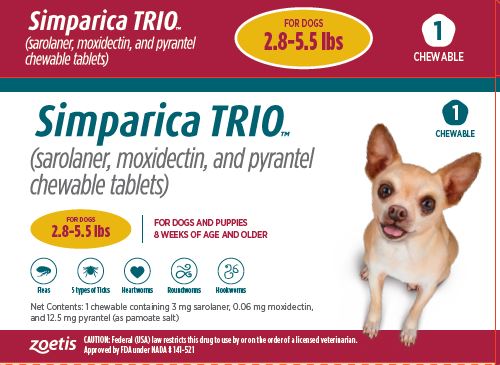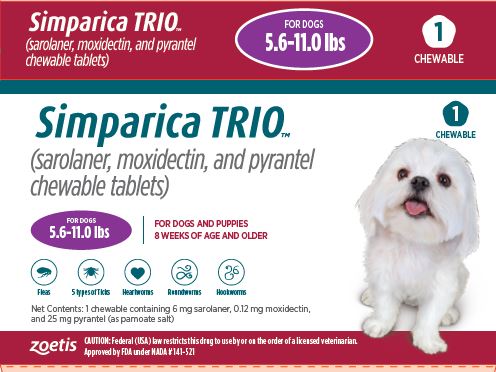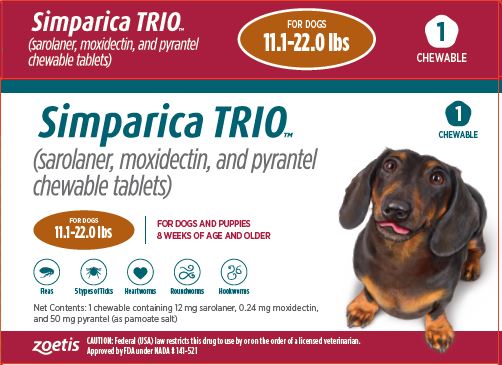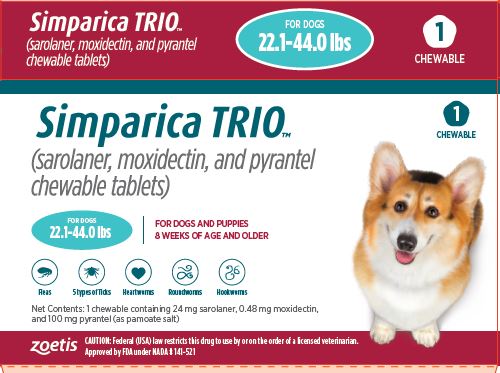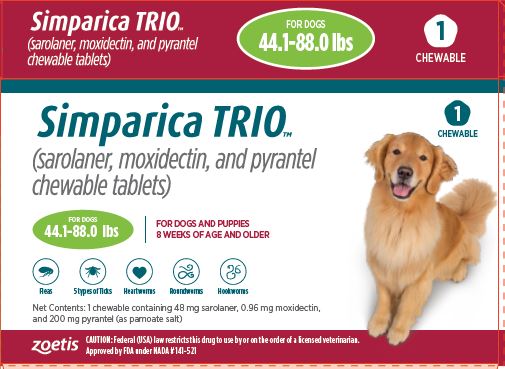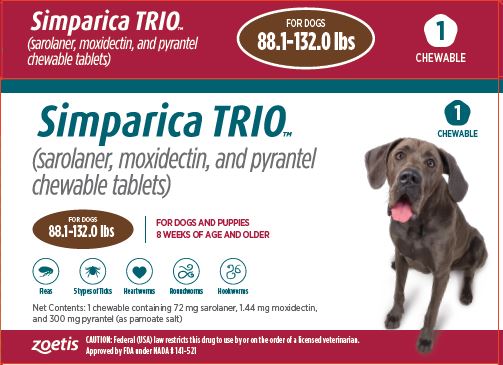SIMPARICA TRIO- sarolaner, moxidectin, and pyrantel tablet, chewable
Simparica TRIO by
Drug Labeling and Warnings
Simparica TRIO by is a Animal medication manufactured, distributed, or labeled by Zoetis Inc.. Drug facts, warnings, and ingredients follow.
Drug Details [pdf]
- SPL UNCLASSIFIED SECTION
- CAUTION
-
DESCRIPTION
SIMPARICA TRIO (sarolaner, moxidectin, and pyrantel chewable tablets) is a flavored, chewable tablet for administration to dogs 8 weeks of age and older. Each tablet is formulated to provide minimum dosages of 0.54 mg/lb (1.2 mg/kg) sarolaner, 0.011 mg/lb (24 μg/kg) moxidectin, and 2.27 mg/lb (5 mg/kg) pyrantel (as pamoate salt).
Sarolaner is a member of the isoxazoline class of parasiticides and the chemical name is 1‑(5’-((5S)-5-(3,5-Dichloro-4-fluorophenyl)-5-trifluoromethyl)-4,5-dihydroisoxazol-3-yl)-3’-H-spiro(azetidine-3,1’-(2)benzofuran)-1-yl)-2-(methylsulfonyl)ethanone. SIMPARICA TRIO contains the S-enantiomer of sarolaner.
Moxidectin is a semi-synthetic methoxime derivative of nemadectin which is a fermentation product of Streptomyces cyaneogriseus subspecies noncyanogenus. Moxidectin is a pentacyclic 16-membered lactone macrolide. The chemical name for moxidectin is (6R,23E,25S)-5-O-Demethyl-28-deoxy-25-[(1E)-1,3-dimethyl-1-buten-1-yl]-6,28-epoxy-23-(methoxyimino)milbemycin B.
Pyrantel belongs to a family classified chemically as tetrahydropyrimidines and the chemical name is (E)‑1,4,5,6-Tetrahydro-1-methyl-2-[2-(2-thienyl) vinyl] pyrimidine 4,4’ methylenebis [3-hydroxy-2-naphthoate] (1:1). It is a yellow, water-insoluble crystalline salt of the tetrahydropyrimidine base and pamoic acid containing 34.7% base activity.
-
INDICATIONS
SIMPARICA TRIO is indicated for the prevention of heartworm disease caused by Dirofilaria immitis and for the treatment and control of roundworm (immature adult and adult Toxocaracanis and adult Toxascaris leonina) and adult hookworm (Ancylostoma caninum and Uncinaria stenocephala) infections. SIMPARICA TRIO kills adult fleas (Ctenocephalides felis) and is indicated for the treatment and prevention of flea infestations, and the treatment and control of tick infestations with Amblyomma americanum (lone star tick), Amblyomma maculatum (Gulf Coast tick), Dermacentor variabilis (American dog tick), Ixodesscapularis (black-legged tick), and Rhipicephalus sanguineus (brown dog tick) for one month in dogs and puppies 8 weeks of age and older, and weighing 2.8 pounds or greater.
-
DOSAGE AND ADMINISTRATION
SIMPARICA TRIO is given orally once a month, at the recommended minimum dose of 0.54 mg/lb (1.2 mg/kg) sarolaner, 0.011 mg/lb (24 μg/kg) moxidectin, and 2.27 mg/lb (5 mg/kg) pyrantel (as pamoate salt).
Dosage Schedule
Body Weight
(lbs)Sarolaner per
Tablet
(mg)Moxidectin
per Tablet
(mg)Pyrantel
per
Tablet
(mg)Number
of Tablets
Administered2.8 to 5.5 3 0.06 12.5 One 5.6 to 11.0 6 0.12 25 One 11.1 to 22.0 12 0.24 50 One 22.1 to 44.0 24 0.48 100 One 44.1 to 88.0 48 0.96 200 One 88.1 to 132.0 72 1.44 300 One >132.0 Administer the appropriate combination of tablets SIMPARICA TRIO can be offered to the dog with or without food.
Care should be taken to ensure that the dog consumes the complete dose and that part of the dose is not lost or refused. If a dose is missed, give SIMPARICA TRIO immediately and resume monthly dosing.Heartworm Prevention:
SIMPARICA TRIO should be administered at monthly intervals year‑round or at least within one month of the animal’s first seasonal exposure to mosquitoes and continuing until at least 1 month after the dog’s last seasonal exposure. If a dose is missed, give SIMPARICA TRIO immediately and resume monthly dosing. When replacing a monthly heartworm preventive product, SIMPARICA TRIO should be given within one month of the last dose of the former medication.Flea Treatment and Prevention:
Treatment with SIMPARICA TRIO may begin at any time of the year. SIMPARICA TRIO should be administered year‑round at monthly intervals or started at least one month before fleas become active. To minimize the likelihood of flea re‑infestation, it is important to treat all dogs and cats within a household with a flea control product.Tick Treatment and Control:
Treatment with SIMPARICA TRIO can begin at any time of the year. SIMPARICA TRIO should be administered year‑round at monthly intervals or started at least one month before ticks become active.Intestinal Nematode Treatment and Control:
For the treatment of roundworm (immature adult and adult Toxocara canis and adult Toxascaris leonina) and adult hookworm (Ancylostoma caninum and Uncinaria stenocephala) infections, SIMPARICA TRIO should be administered once as a single dose. Monthly use of SIMPARICA TRIO will control any subsequent infections - CONTRAINDICATIONS
- WARNINGS
-
PRECAUTIONS
Sarolaner, one of the ingredients in SIMPARICA TRIO, is a member of the isoxazoline class. This class has been associated with neurologic adverse reactions including tremors, ataxia, and seizures. Seizures have been reported in dogs receiving isoxazoline class drugs, even in dogs without a history of seizures. Use with caution in dogs with a history of seizures or neurologic disorders.
Prior to administration of SIMPARICA TRIO, dogs should be tested for existing heartworm infections. Infected dogs should be treated with an adulticide to remove adult heartworms. SIMPARICA TRIO is not effective against adult D. immitis.
The safe use of SIMPARICA TRIO has not been evaluated in breeding, pregnant, or lactating dogs.
-
ADVERSE REACTIONS
In a field safety and effectiveness study, SIMPARICA TRIO was administered to dogs for the prevention of heartworm disease. The study included a total of 410 dogs treated once monthly for 11 treatments (272 treated with SIMPARICA TRIO and 138 treated with an active control). Over the 330-day study period, all observations of potential adverse reactions were recorded. The most frequent reactions reported in the SIMPARICA TRIO group are presented in the following table.
Table 1. Dogs with Adverse Reactions
Clinical Sign SIMPARICA TRIO
n = 272Active Control
n = 138Vomiting 14.3% 10.9% Diarrhea 13.2% 8.0% Lethargy 8.5% 6.5% Anorexia 5.1% 5.8% Polyuria 3.7% 3.6% Hyperactivity 2.2% 0.7% Polydipsia 2.2% 2.9% In a second field safety and effectiveness study, SIMPARICA TRIO was administered to 278 dogs with fleas. Adverse reactions in dogs treated with SIMPARICA TRIO included diarrhea.
In a third field safety and effectiveness study, SIMPARICA TRIO was administered to 120 dogs with roundworms. Adverse reactions in dogs treated with SIMPARICA TRIO included diarrhea and vomiting.
For a copy of the Safety Data Sheet or to report adverse reactions, call Zoetis Inc. at 1-888-963-8471. For additional information about adverse drug experience reporting for animal drugs, contact FDA at 1-888-FDA-VETS or www.fda.gov/reportanimalae. -
CLINICAL PHARMACOLOGY
Following oral administration of SIMPARICA TRIO in Beagle dogs (13 to 15 months of age at the time of initial dosing), sarolaner and moxidectin were rapidly and well-absorbed. Following a single oral dose of SIMPARICA TRIO (sarolaner dose of 1.2 mg/kg), the sarolaner mean maximum plasma concentration (Cmax) was 523 ng/mL with a mean time to maximum concentration (Tmax) of 3.5 hours and an absolute bioavailability of 88%. At a moxidectin dose of 0.024 mg/kg, the moxidectin mean Cmax was 13.1 ng/mL with a mean Tmax of 2.4 hours and an absolute bioavailability of 67%.
Following intravenous (IV) dosing of a combination solution of sarolaner and moxidectin, the sarolaner volume of distribution (Vss) was 2.4 L/kg and systemic clearance (CL) was 6.0 mL/kg/hr. For moxidectin the Vss was 7.65 L/kg and CL was 26.6 mL/kg/hr. The terminal half‑lives were similar after oral and IV dosing for both sarolaner (12 days) and moxidectin (11 days). The primary route of elimination of both sarolaner and moxidectin is biliary excretion with minimal metabolism.
Following an oral dose of SIMPARICA TRIO containing 5 mg/kg pyrantel (as pamoate salt), pyrantel has measurable plasma concentrations, but they are low and highly variable. Pyrantel pamoate is intended to remain in the gastrointestinal tract allowing for delivery of effective concentrations to gastrointestinal nematodes.
-
MODE OF ACTION
SIMPARICA TRIO contains three active pharmaceutical ingredients, sarolaner, moxidectin, and pyrantel pamoate.
Sarolaner is an acaricide and insecticide belonging to the isoxazoline group. Sarolaner inhibits the function of the neurotransmitter gamma aminobutyric acid (GABA) receptor and glutamate receptor, and works at the neuromuscular junction in insects. This results in uncontrolled neuromuscular activity leading to death in insects or acarines.
Moxidectin is an endectocide in the macrocyclic lactone class. Moxidectin acts by interfering with the chloride channel‑mediated neurotransmission in the parasite. This results in paralysis and death of the parasite.
Pyrantel pamoate is a nematocide belonging to the tetrahydropyrimidine class. Pyrantel acts as a depolarizing, neuromuscular‑blocking agent in susceptible parasites, which causes paralysis and death or expulsion of the organism.
-
EFFECTIVENESS
Heartworm Prevention
In two well‑controlled laboratory studies, a single oral dose of SIMPARICA TRIO was 100% effective in preventing the development of adult D. immitis in dogs inoculated with infective larvae 30 days before treatment.
In a well-controlled US field study consisting of 246 dogs administered SIMPARICA TRIO and 119 administered an active control, no dogs treated with SIMPARICA TRIO tested positive for heartworm disease. All dogs treated with SIMPARICA TRIO were negative for D. immitis antigen and blood microfilariae at study completion on day 330.
Flea Treatment and Prevention
In a well‑controlled laboratory study, SIMPARICA TRIO began to kill fleas at 4 hours and demonstrated 100% effectiveness at 8 hours after initial administration. After weekly re‑infestations, SIMPARICA TRIO reduced the number of live fleas by ≥97.8% within 12 hours of infestation for 28 days.
In a separate well‑controlled laboratory study, SIMPARICA TRIO demonstrated 100% effectiveness against adult fleas within 24 hours following treatment and maintained ≥99.7% effectiveness against weekly re‑infestations for 35 days.
In a study to explore flea egg production and viability, SIMPARICA TRIO killed fleas before they could lay eggs for 35 days.
In a well‑controlled 60‑day US field study conducted in dogs with existing flea infestations of varying severity, the effectiveness of SIMPARICA TRIO against fleas on Day 30 and 60 visits was 99.0% and 99.7%, respectively, compared to baseline. Dogs with signs of flea allergy dermatitis showed improvement in erythema, papules, scaling, alopecia, dermatitis/pyodermatitis and pruritus as a direct result of eliminating fleas.
Tick Treatment and Control
In a well‑controlled laboratory study, SIMPARICA TRIO began to kill existing I. scapularis within 8 hours, SIMPARICA TRIO reduced the number of live ticks by ≥94.2% within 24 hours of infestation for 28 days.
In well‑controlled laboratory studies, SIMPARICA TRIO demonstrated ≥98.9% effectiveness against an existing infestation of Amblyomma maculatum, Ixodes scapularis, Rhipicephalus sanguineus, and Dermacentor variabilis 48 hours post‑administration and maintained ≥90.4% effectiveness 48 hours after re‑infestation for at least 28 days. Against Amblyomma americanum, SIMPARICA TRIO demonstrated ≥99.4% effectiveness 72 hours after treatment of existing infestations, and maintained ≥98.4% effectiveness 72 hours after re‑infestation for at least 28 days.
Intestinal Nematode Treatment and Control
Elimination of roundworms (immature adult and adult Toxocara canis and adult Toxascaris leonina) and adult hookworms (Ancylostoma caninum and Uncinaria stenocephala) was demonstrated in well‑controlled laboratory studies.
In a 10-day multi‑center field study, SIMPARICA TRIO was effective against Toxocara canis and reduced fecal egg counts 99.2%.
-
ANIMAL SAFETY
Margin of Safety: SIMPARICA TRIO was administered orally to 8‑week‑old Beagle puppies at doses of 1, 3, and 5X the maximum labeled dose (2.4 mg/kg sarolaner, 48 μg/kg moxidectin, and 10 mg/kg pyrantel) at 28 day intervals for 7 treatments. Dogs in the control group received placebo. There were no clinically‑relevant, treatment related effects on clinical observations, body weights, food consumption, clinical pathology (hematology, coagulation, serum chemistry, and urinalysis), gross pathology, histopathology, or organ weights. During the end-of-study ophthalmic examination, the following change was found: one 1X dog had retinal dysplasia (OS folds).
Ivermectin-sensitive Collie Safety:
SIMPARICA TRIO was administered orally once at 1, 3 and 5X the maximum labeled dose to Collies that had been pre‑screened for avermectin sensitivity. Dogs in the control group received placebo. Clinical signs (ataxia, muscle fasciculations, mydriasis) associated with avermectin sensitivity were observed in the 5X group. All dogs were completely recovered by the third day of the study.Heartworm-Positive Safety:
SIMPARICA TRIO was administered orally at 1 and 3X the maximum labeled dose at 28 day intervals for 3 treatments to Beagle dogs with patent adult heartworm infections and circulating microfilariae. Dogs in the control group received placebo. Diarrhea occurred more commonly in the treated dogs and also more often in the 3X group compared with the 1X group. Two dogs (1 each in 1X and 3X) developed a fever less than 24 hours after the first dose. The fever may have been a transient reaction to a rapid microfilaria reduction. Both dogs recovered without treatment.Field Safety: In three well‑controlled field studies, SIMPARICA TRIO was used concurrently with other medications such as vaccines, antimicrobials, anthelmintics, antiprotozoals, steroidal and non‑steroidal anti‑inflammatory agents, anesthetic agents and analgesics. No adverse reactions were associated with the concurrent use of SIMPARICA TRIO and other medications.
- STORAGE CONDITIONS
- HOW SUPPLIED
- SPL UNCLASSIFIED SECTION
- PRINCIPAL DISPLAY PANEL - 3mg x 1 Carton
- PRINCIPAL DISPLAY PANEL - 6mg x 1 Carton
- PRINCIPAL DISPLAY PANEL - 12mg x 1 Carton
- PRINCIPAL DISPLAY PANEL - 24mg x 1 Carton
- PRINCIPAL DISPLAY PANEL - 48mg x 1 Carton
- PRINCIPAL DISPLAY PANEL - 72mg x 1 Carton
-
INGREDIENTS AND APPEARANCE
SIMPARICA TRIO
sarolaner, moxidectin, and pyrantel tablet, chewableProduct Information Product Type PRESCRIPTION ANIMAL DRUG Item Code (Source) NDC: 54771-2667 Route of Administration ORAL Active Ingredient/Active Moiety Ingredient Name Basis of Strength Strength SAROLANER (UNII: DM113FTW7F) (SAROLANER - UNII:DM113FTW7F) SAROLANER 3 mg MOXIDECTIN (UNII: NGU5H31YO9) (MOXIDECTIN - UNII:NGU5H31YO9) MOXIDECTIN .06 mg PYRANTEL PAMOATE (UNII: 81BK194Z5M) (PYRANTEL - UNII:4QIH0N49E7) PYRANTEL 12.5 mg Product Characteristics Color BROWN (reddish brown) Score no score Shape PENTAGON (5 SIDED) (rounded edges) Size 9mm Flavor Imprint Code Contains Packaging # Item Code Package Description Marketing Start Date Marketing End Date 1 NDC: 54771-2667-1 1 in 1 CARTON 1 1 in 1 BLISTER PACK 2 NDC: 54771-2667-2 1 in 1 CARTON 2 3 in 1 BLISTER PACK 3 NDC: 54771-2667-3 1 in 1 CARTON 3 6 in 1 BLISTER PACK Marketing Information Marketing Category Application Number or Monograph Citation Marketing Start Date Marketing End Date NADA NADA141521 03/02/2020 SIMPARICA TRIO
sarolaner, moxidectin, and pyrantel tablet, chewableProduct Information Product Type PRESCRIPTION ANIMAL DRUG Item Code (Source) NDC: 54771-2684 Route of Administration ORAL Active Ingredient/Active Moiety Ingredient Name Basis of Strength Strength SAROLANER (UNII: DM113FTW7F) (SAROLANER - UNII:DM113FTW7F) SAROLANER 6 mg MOXIDECTIN (UNII: NGU5H31YO9) (MOXIDECTIN - UNII:NGU5H31YO9) MOXIDECTIN .12 mg PYRANTEL PAMOATE (UNII: 81BK194Z5M) (PYRANTEL - UNII:4QIH0N49E7) PYRANTEL 25 mg Product Characteristics Color BROWN (reddish brown) Score no score Shape PENTAGON (5 SIDED) (rounded edges) Size 11mm Flavor Imprint Code Contains Packaging # Item Code Package Description Marketing Start Date Marketing End Date 1 NDC: 54771-2684-1 1 in 1 CARTON 1 1 in 1 BLISTER PACK 2 NDC: 54771-2684-2 1 in 1 CARTON 2 3 in 1 BLISTER PACK 3 NDC: 54771-2684-3 1 in 1 CARTON 3 6 in 1 BLISTER PACK Marketing Information Marketing Category Application Number or Monograph Citation Marketing Start Date Marketing End Date NADA NADA141521 03/02/2020 SIMPARICA TRIO
sarolaner, moxidectin, and pyrantel tablet, chewableProduct Information Product Type PRESCRIPTION ANIMAL DRUG Item Code (Source) NDC: 54771-2668 Route of Administration ORAL Active Ingredient/Active Moiety Ingredient Name Basis of Strength Strength SAROLANER (UNII: DM113FTW7F) (SAROLANER - UNII:DM113FTW7F) SAROLANER 12 mg MOXIDECTIN (UNII: NGU5H31YO9) (MOXIDECTIN - UNII:NGU5H31YO9) MOXIDECTIN .24 mg PYRANTEL PAMOATE (UNII: 81BK194Z5M) (PYRANTEL - UNII:4QIH0N49E7) PYRANTEL 50 mg Product Characteristics Color BROWN (reddish brown) Score no score Shape PENTAGON (5 SIDED) (rounded edges) Size 14mm Flavor Imprint Code Contains Packaging # Item Code Package Description Marketing Start Date Marketing End Date 1 NDC: 54771-2668-1 1 in 1 CARTON 1 1 in 1 BLISTER PACK 2 NDC: 54771-2668-2 1 in 1 CARTON 2 3 in 1 BLISTER PACK 3 NDC: 54771-2668-3 1 in 1 CARTON 3 6 in 1 BLISTER PACK Marketing Information Marketing Category Application Number or Monograph Citation Marketing Start Date Marketing End Date NADA NADA141521 03/02/2020 SIMPARICA TRIO
sarolaner, moxidectin, and pyrantel tablet, chewableProduct Information Product Type PRESCRIPTION ANIMAL DRUG Item Code (Source) NDC: 54771-2669 Route of Administration ORAL Active Ingredient/Active Moiety Ingredient Name Basis of Strength Strength SAROLANER (UNII: DM113FTW7F) (SAROLANER - UNII:DM113FTW7F) SAROLANER 24 mg MOXIDECTIN (UNII: NGU5H31YO9) (MOXIDECTIN - UNII:NGU5H31YO9) MOXIDECTIN .48 mg PYRANTEL PAMOATE (UNII: 81BK194Z5M) (PYRANTEL - UNII:4QIH0N49E7) PYRANTEL 100 mg Product Characteristics Color BROWN (reddish brown) Score no score Shape PENTAGON (5 SIDED) (rounded edges) Size 17mm Flavor Imprint Code Contains Packaging # Item Code Package Description Marketing Start Date Marketing End Date 1 NDC: 54771-2669-1 1 in 1 CARTON 1 1 in 1 BLISTER PACK 2 NDC: 54771-2669-2 1 in 1 CARTON 2 3 in 1 BLISTER PACK 3 NDC: 54771-2669-3 2 in 1 CARTON 3 3 in 1 BLISTER PACK Marketing Information Marketing Category Application Number or Monograph Citation Marketing Start Date Marketing End Date NADA NADA141521 03/02/2020 SIMPARICA TRIO
sarolaner, moxidectin, and pyrantel tablet, chewableProduct Information Product Type PRESCRIPTION ANIMAL DRUG Item Code (Source) NDC: 54771-2670 Route of Administration ORAL Active Ingredient/Active Moiety Ingredient Name Basis of Strength Strength SAROLANER (UNII: DM113FTW7F) (SAROLANER - UNII:DM113FTW7F) SAROLANER 48 mg MOXIDECTIN (UNII: NGU5H31YO9) (MOXIDECTIN - UNII:NGU5H31YO9) MOXIDECTIN .96 mg PYRANTEL PAMOATE (UNII: 81BK194Z5M) (PYRANTEL - UNII:4QIH0N49E7) PYRANTEL 200 mg Product Characteristics Color BROWN (reddish brown) Score no score Shape PENTAGON (5 SIDED) (rounded edges) Size 20mm Flavor Imprint Code Contains Packaging # Item Code Package Description Marketing Start Date Marketing End Date 1 NDC: 54771-2670-1 1 in 1 CARTON 1 1 in 1 BLISTER PACK 2 NDC: 54771-2670-2 1 in 1 CARTON 2 3 in 1 BLISTER PACK 3 NDC: 54771-2670-3 2 in 1 CARTON 3 3 in 1 BLISTER PACK Marketing Information Marketing Category Application Number or Monograph Citation Marketing Start Date Marketing End Date NADA NADA141521 03/02/2020 SIMPARICA TRIO
sarolaner, moxidectin, and pyrantel tablet, chewableProduct Information Product Type PRESCRIPTION ANIMAL DRUG Item Code (Source) NDC: 54771-2671 Route of Administration ORAL Active Ingredient/Active Moiety Ingredient Name Basis of Strength Strength SAROLANER (UNII: DM113FTW7F) (SAROLANER - UNII:DM113FTW7F) SAROLANER 72 mg MOXIDECTIN (UNII: NGU5H31YO9) (MOXIDECTIN - UNII:NGU5H31YO9) MOXIDECTIN 1.44 mg PYRANTEL PAMOATE (UNII: 81BK194Z5M) (PYRANTEL - UNII:4QIH0N49E7) PYRANTEL 300 mg Product Characteristics Color BROWN (reddish brown) Score no score Shape PENTAGON (5 SIDED) (rounded edges) Size 24mm Flavor Imprint Code Contains Packaging # Item Code Package Description Marketing Start Date Marketing End Date 1 NDC: 54771-2671-1 1 in 1 CARTON 1 1 in 1 BLISTER PACK 2 NDC: 54771-2671-2 1 in 1 CARTON 2 3 in 1 BLISTER PACK 3 NDC: 54771-2671-3 2 in 1 CARTON 3 3 in 1 BLISTER PACK Marketing Information Marketing Category Application Number or Monograph Citation Marketing Start Date Marketing End Date NADA NADA141521 03/02/2020 Labeler - Zoetis Inc. (828851555)
Trademark Results [Simparica TRIO]
Mark Image Registration | Serial | Company Trademark Application Date |
|---|---|
 SIMPARICA TRIO 87746787 not registered Live/Pending |
Zoetis Services LLC 2018-01-08 |
© 2025 FDA.report
This site is not affiliated with or endorsed by the FDA.
